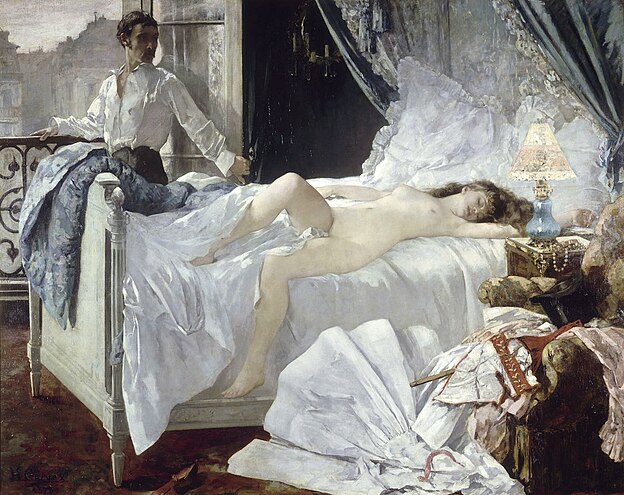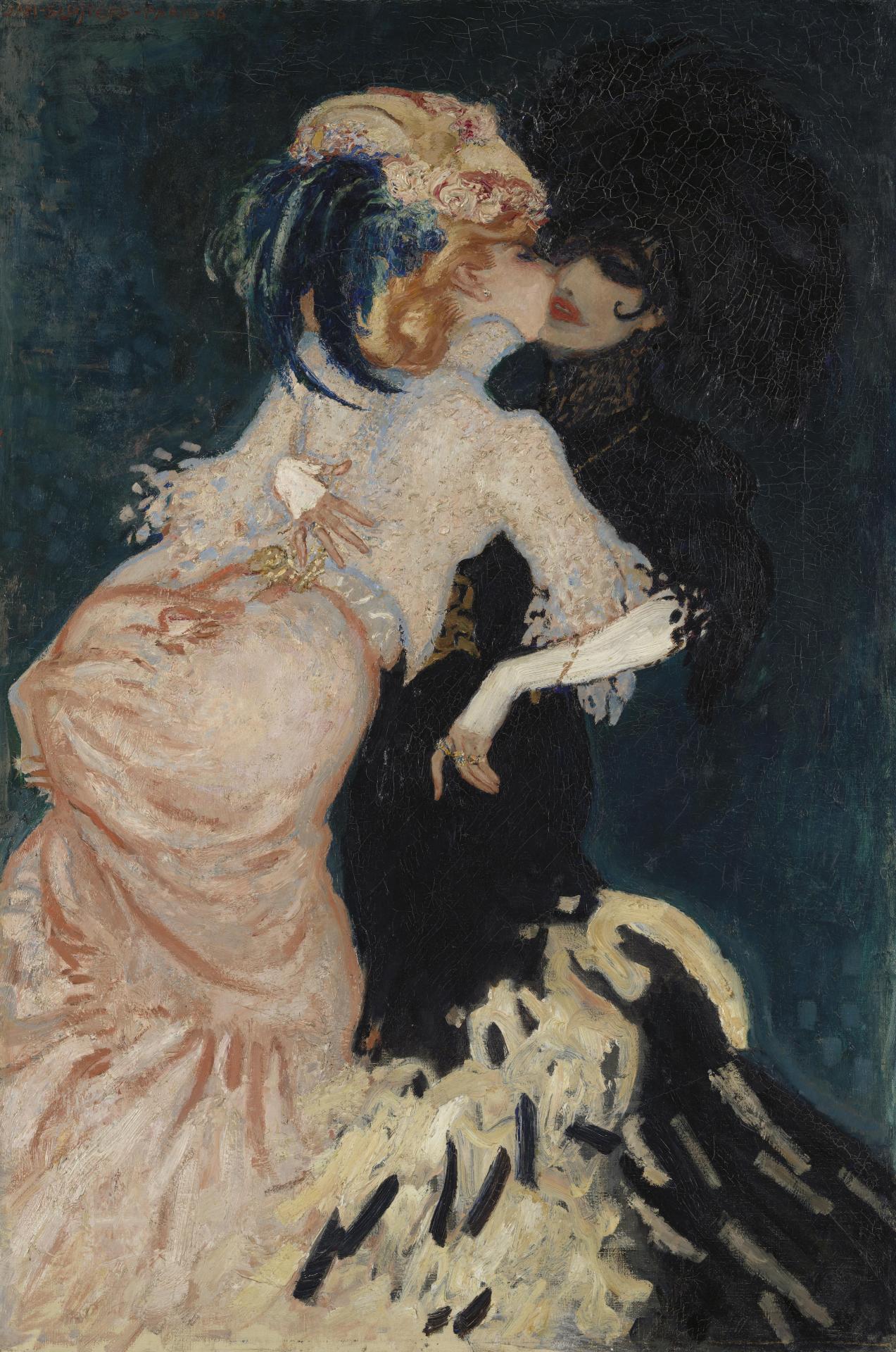Large-scale exhibition at Van Gogh Museum in collaboration with Musée d’Orsay.
Easy Virtue will run from 19 February to 19 June 2016 at the
Van Gogh Museum. The exhibition, organised in collaboration with the
Musée d’Orsay, explores the depiction of prostitution in French art in
the period 1850–1910. It is the first time that the subject has been
highlighted at a major exhibition. The first showing at the Musée
d’Orsay in Paris under the title Splendeurs et Misères attracted nearly 420,000 visitors.Easy Virtue at the Van Gogh Museum in Amsterdam will now examine how the theme of prostitution was dealt with by a variety of artists. Over 100 paintings and works on paper by more than 40 different artists can be admired, including big names like Van Gogh, Degas, Toulouse-Lautrec and Picasso. The exhibits include loans from international museums and private collections, the vast majority of which have never been shown before in the Netherlands. Interesting historical items also feature, such as a police record, pornographic photographs, a 19th-century ornamental bed and a whip belonging to a famous courtesan.
Prostitution was a favourite theme in visual art in the second half of the 19th century. Inspired by Baudelaire’s dictum that art should represent modern life, artists depicted prostitution as an aspect of contemporary urban life in Paris. They painted women soliciting on the boulevards, wealthy courtesans in their salons, and worn-down prostitutes in brothels. It was a topical theme, reflecting frequent social debates about the dangers of prostitution and the benefits and drawbacks of regulation.
Easy Virtue: Prostitution in French Art, 1850–1910 examines what it was that drew artists to this complex and sensitive subject between the Second Empire and the belle époque. The exhibition shows the world of Paris prostitutes as recorded by a variety of painters and draughtsmen: a world of contrasts, of luxury, make-up and glamour, but also of poverty, disease and misery.
Unique and for the first time in the Netherlands This is the first time that the theme of prostitution has been examined in such detail in an exhibition. Easy Virtue: Prostitution in French Art, 1850–1910 comprises over 150 objects, including more than 100 paintings, works on paper, sculpture and decorative art. There are striking and famous masterpieces by big names like Édouard Manet, Edgar Degas, Henri de Toulouse-Lautrec, Pablo Picasso, Kees van Dongen, František Kupka and Vincent van Gogh, as well as works by lesser-known artists such as Louis Anquetin, Henri Gervex, Jean Béraud, Félicien Rops and Auguste Chabaud. High-level visual art is complemented in Easy Virtue by photographs, books, magazine illustrations and intriguing and curious objects like pornographic photographs, a police record with photos of arrested prostitutes, a gilded and decorated ornamental bed, and the whip that belonged to the celebrated courtesan Valtesse de la Bigne.
Visitors to the exhibition will be transported from the dance-halls and cafés where women picked up their clients, to the closed world of the brothel and of prison, where illegal prostitutes and women suffering from venereal disease were incarcerated. Easy Virtue: Prostitution in French Art, 1850–1910 has been designed by Clement & Sanôu – an Amsterdam duo known for their costume, lighting and set designs for opera, ballet and theatre, including the Dutch National Ballet’s recent Mata Hari.
Uncertainty and ambiguity
Easy Virtue is organised around four themed ‘chapters’. The exhibition begins with Uncertainty and ambiguity, which shows how painters visualised prostitution in the public space. Prostitution was legalised in France in the early 19th century. It was viewed as a necessary evil, which had to be controlled and hidden away as much as possible in order to protect public morals and to counter the spread of venereal disease. Street prostitution was only permitted in the evening (after l’heure du gaz when the gaslights were lit) and for prostitutes who were registered with the police. Many women also worked illegally, however. Prostitutes were not always readily distinguishable from ‘respectable’ women in the street or when out and about at night. Artists incorporated subtle references to this ambiguity in their paintings, using colours, poses, meaningful looks or the interaction between their figures.The most important works in Uncertainty and ambiguity are:
- Woman on the Champs-Elysées at Night, 1890–91 by Louis Anquetin (Van Gogh Museum Amsterdam, acquired with the support of BankGiro Loterij and the Rembrandt Association),
- Edgar Degas, Absinthe, 1875–6, oil on canvas, 36 ¼ × 27 in., Paris, Musée d’Orsay
- Moulin de la Galette, 1889 by Henri de Toulouse-Lautrec (The Art Institute of Chicago),
- Study for ‘Flirt’ (The Englishman in the Moulin Rouge), 1892 by Henri de Toulouse-Lautrec (The Metropolitan Museum, New York)
- Waiting, c. 1885 by Jean Béraud (Musée d’Orsay, Paris).
The Splendour of the Courtesans
The chapter The Splendour of the Courtesans shows how courtesans were depicted in art. These expensive escorts and stars of haute prostitution often began their career on stage or as ‘ordinary’ prostitutes. Having risen to prominence by sharing the beds of rich men and politicians, they enjoyed a certain status and flaunted their social success by having their portraits made in paintings, sculptures and photographs, which they spread as widely as they could. The flamboyant courtesan was worshipped in the theatre, followed by the press and was even a trendsetter when it came to fashion.One of the most famous courtesans was La Païva (1819–1884). Born Thérèse Lachmann into a poor Jewish family in Moscow, she moved to Paris, where she climbed the ladder to become the most successful courtesan of the 19th century. She was renowned for the extravagant parties and dinners she held for the Paris beau monde, which were regularly attended by politicians, noblemen and writers like Gustave Flaubert and Emile Zola. Several pieces of furniture from her house can be seen at Easy Virtue. There is also a 19th-century gilded bed, decorated with a figure of Leda and the swan and little angels, which probably belonged to a courtesan or came from one of the many brothels in Paris.
The most important works in The Splendour of the Courtesans are:
- Charles Carolus-Duran, Portrait of Julia Tahl known as Mademoiselle Alice de Lancey, 1876, Oil on canvas, 60 × 83 in. (152.5 × 211 cm) Petit Palais, Musée des Beaux-Arts de la Ville de Paris, Paris
- Rolla, 1878 by Henri Gervex (Musée d’Orsay, Paris)
- The Thorny Path (The Courtesan’s Carriage or The Modern Courtesan), 1873 by Thomas Couture (Philadelphia Museum of Art).
At the Brothel: from Anticipation to Seduction
The next chapter in the exhibition is At the Brothel: from Anticipation to Seduction, which reveals the hidden world of the brothel – a rewarding subject for artists looking for modern material. It gave them the opportunity to experiment with a new and unconventional way of representing the female nude and to depict what went on behind those closed doors: the game of anticipation and seduction, but also the everyday lives of the prostitutes. Artists painted the endless waiting around for clients, but also intimate, domestic scenes with the women in conversation, eating their meals or washing and dressing, sometimes in the presence of a customer.The most important works in At the brothel: anticipation and seduction are:
- In the Salon: the Couch, c. 1893 by Henri de Toulouse-Lautrec (Museu de Arte de São Paulo Assis Chateaubriand),
- The Customer, 1878 by Jean-Louis Forain (Dixon Gallery and Gardens, Memphis),
- Henri de Toulouse-Lautrec, Woman Pulling up her Stockings, 1893, oil on cardboard, 22 ¾ × 18 in., Paris, Musée d’Orsay
- Study for Reclining Female Nude, 1887 by Vincent van Gogh (Van Gogh Museum, Amsterdam (Vincent van Gogh Foundation).
Debauchery in Colour and Form
The final chapter of the exhibition, Debauchery in Colour and Form, focuses on the modern era from the turn of the 20th century to 1910. Prostitution had become an established avant-garde theme by that time. Rather than being hidden, it was now visualised explicitly, verging at times on the caricature. Artists were concerned less about the theme as such than with colour, form and expressiveness. This new generation of painters tended to present the prostitute as a solitary figure, no longer in the context of a brothel. Some saw the Paris prostitute as an attractive subject for colourful canvases showing sensual, loose women, while others took a very different approach, presenting her in a raw style as a prisoner in a world of darkness.The most important works in this section are:
- In a Private Dining Room (At Le Rat mort), 1899 by Henri de Toulouse-Lautrec (The Courtauld Gallery, London),
- Women Kissing, 1906 by Jan Sluijters (Van Gogh Museum, Amsterdam),
- Nude with Red Stocking, 1901 by Pablo Picasso (Musée des Beaux-Arts, Lyon),
- Melancholy Woman, 1902 by Pablo Picasso (The Detroit Institute of Arts),
- František Kupka, Gallien’s Girl, 1909–10, oil on canvas, 42 ½ × 38 ¾ in., Prague, Národní Gallery. The Kupka image is NOT free of copyright
- André Derain, Woman in a Chemise or Dancer, 1906, oil on canvas, 39 ¼ × 32 in., Copenhagen, Statens Museum for Kunst. The Derain image is NOT free of copyright
Prints-Prostitution-Privacy
In parallel with Easy Virtue, the Print Room in the Van Gogh Museum’s exhibition wing is showing a selection of 19th-century prints under the title Prints-Prostitution-Privacy. These intimate little artworks, whether autonomous or illustrations for erotic texts, seem to whisper a secret to the viewer. Women of easy virtue were depicted partially or entirely undressed, in poses and situations varying from suggestive to explicitly sexual. The prints, produced in limited editions, were intended for a closed circle of artists, publishers, dealers and collectors, who belonged to the decadent sub-culture within the Paris elite. They kept the separate prints in portfolios and viewed them in the privacy of their studies or in the gallery. Erotica was viewed as a natural expression of the ‘French spirit’, so long as it was artistically presented. In this way, works of a sensual nature could be kept out of sight of government censors and other moral crusaders.New acquisition
The Prints-Prostitution-Privacy exhibit also features an exceptional new acquisition by the Van Gogh Museum:La lecture après le bain, 1879–83, by Edgar Degas (1834–1917).
Degas made his erotic monotypes (one-off prints) of prostitutes primarily for himself. He covered a sheet of glass with black ink, which he then wiped and scratched away to conjure nudes out of the darkness. The dozens of ‘black’ prints he created were only discovered in his studio after his death. La lecture après le bain was purchased with the support of the BankGiro Loterij, the Mondriaan Fund and the Rembrandt Association.
Catalogue
The exhibition is accompanied by the richly illustrated book Easy Virtue: Prostitution in French Art, 1850–1910 (also available in Dutch), Van Gogh Museum/Musée d’Orsay, 192 pages.The catalogue Splendours and Miseries: Images of Prostitution in France, 1850–1910, Musée d’Orsay/Flammarion is also available, 308 pages.
Excellent reviews here
and here.




.jpg)





